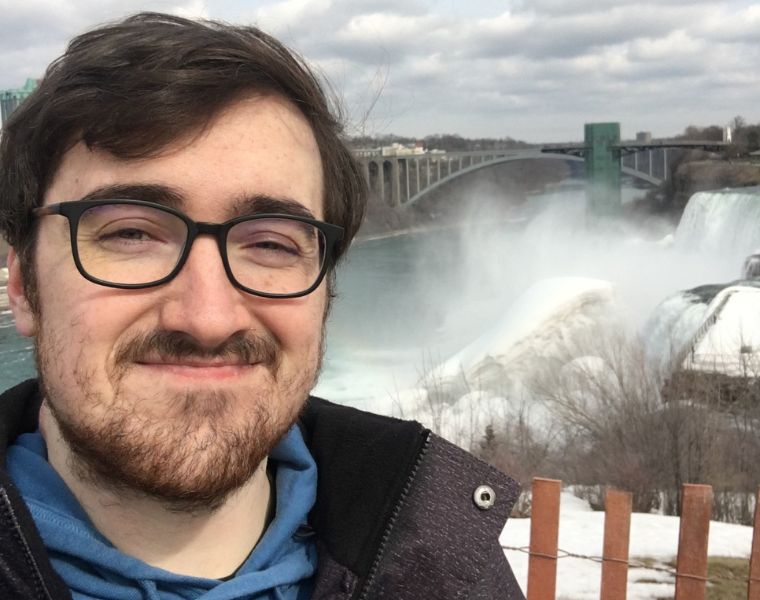
As a high school student searching for colleges, Ray Garner had his eye on Case Western Reserve University from the start. He was attracted to the university’s renowned reputation and stellar astronomy program, but ended up earning his undergraduate degree from Furman University in Greenville, South Carolina, after landing on CWRU’s waitlist.
Garner didn’t forget about CWRU, though. Four years after he’d first applied, the Las Vegas-born, Georgia-raised student was accepted into the university’s PhD in astronomy program, enrolling in fall 2018.
“Admittedly, I knew moving up here to Cleveland meant leaving good sweet tea and warm winters behind, but I was willing to make that sacrifice!” he said.
And it was well worth it. Garner has not only made a name for himself at the university, but also in the field of astronomy. With a focus on galaxy evolution, his research on the nearby spiral galaxy M101 was published late last year in the The Astrophysical Journal.
We spoke with Garner to learn more about his research and what his plans are as he prepares to graduate this summer.
Answers have been lightly edited for clarity and length.
1. What inspired you to study astronomy?
I was always interested in science and math as a kid, and astronomy just grabs your mind and makes you wonder about what’s out there. It’s also a weird science: unlike, say, chemistry, astronomers can’t touch, taste, hear or smell what we study. We can only watch and observe. The fact that you can get any information out just from looking at an object is absolutely amazing. I guess that challenge is what inspired me to study astronomy.
2. What are your post-grad plans?
In the short-term, I’ve accepted a postdoc position at Texas A&M working with Rob Kennicutt, an astronomer so famous that he’s got an astrophysical law named after him! My work here at CWRU prepared me so well, Rob Kennicutt told me that I was the only one he interviewed for the job because I had everything he was looking for. In the long-term, I want to end up teaching at a college, sharing my love of the universe with students.
3. Can you describe your research?
In short, I study galaxy evolution by looking at one galaxy really really hard. I study the Pinwheel Galaxy (M101), a nearby spiral galaxy, using images that were taken at CWRU’s telescope out at Kitt Peak, Arizona, that capture certain wavelengths of light. This light can tell us how fast this galaxy is producing stars, where it’s producing stars, and even how enriched it is with elements heavier than helium. Even the absence of that light can tell us about the ages of its stars!
I’m looking at all of this because the Pinwheel Galaxy probably interacted with another nearby, smaller galaxy about 300 million years ago and we want to know what effects that had on the Pinwheel Galaxy. We know the interaction messed up its appearance (it’s got what I lovingly call a big wonky arm), but what are the more subtle consequences of this interaction? That’s what I’m trying to figure out.
4. What led you to explore that topic?
Basically, I explored this specific topic because it was data that my advisor, Professor Chris Mihos, was collecting. But galaxy evolution in general is interesting to me because everything looks so motionless on the night sky. You can’t even imagine those stars and galaxies moving and rotating, and yet simply by taking images of them we can measure that motion. We can see back in time and see the repercussions of two galaxies passing by each other in the night. That has a sort of magical quality to it that I absolutely enjoy.
5. When conducting your research, did you have an “aha” moment?
Yes! In normal spiral galaxies, the inner regions are more enriched than the outer regions. But in some galaxies, like the Pinwheel Galaxy, the inner region is definitely more enriched, but the outer region is more enriched than it should be. I realized that what I was observing in the level of enrichment in the Pinwheel Galaxy could be caused by a dynamical effect known as “corotation.” Basically, corotation acts as a barrier in the galaxy, keeping the inner and outer regions separate. That would mean that the enriched material in the galaxy couldn’t mix well and the outer region would just keep getting more and more enriched as time went by. Furthermore, the point where the “extra” enrichment started was right where corotation was! Putting those pieces together, linking chemical evolution with a dynamics argument, was a big moment for me. It’s like everything just fit together!
6. What do you hope will come of your research? Are there any advances you expect it to lead to?
Well, I hope to continue some of my research while I’m at Texas A&M. And I hope it will expand the general knowledge that we’re lacking regarding when small galaxies interact with bigger galaxies (as opposed to two massive galaxies crashing into each other). Generally, I hope it will show that in an era of astronomy where spectroscopy is all the rage, plain old images can still deliver important scientific results.
7. What have you enjoyed most about your time at CWRU?
The thing I have enjoyed the most has been all of my work with the Graduate Council of Arts & Sciences, the grad student body that represents all of the graduate students in the College of Arts & Sciences. During my past three years as an officer (one as treasurer, two as co-president), I have gotten to know so many students from various disciplines and walks of life on campus. Plus, I really have enjoyed fighting for my fellow graduate students on campus and trying to make their time here at CWRU easier and less stressful. It has really opened up my eyes to lots of issues that people face on campus and in their lives, and that we can help people out just by being kind and understanding. That’s something I will take with me the rest of my life.

